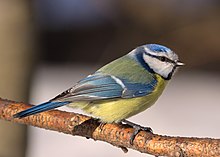藍山雀
藍山雀(學名: Cyanistes caeruleus),又名藍冠山雀,是長10.5-12厘米的山雀。牠們分佈在歐洲溫帶及亞北極帶並西亞的林地。牠們並非候鳥。
| 藍山雀 | |
|---|---|

| |
| 科學分類 | |
| 界: | 動物界 Animalia |
| 門: | 脊索動物門 Chordata |
| 綱: | 鳥綱 Aves |
| 目: | 雀形目 Passeriformes |
| 科: | 山雀科 Paridae |
| 屬: | 藍山雀屬 Cyanistes |
| 種: | 藍山雀 C. caeruleus
|
| 二名法 | |
| Cyanistes caeruleus (Linnaeus, 1758)
| |

| |
| 異名 | |
|
Parus caeruleus | |
分類
編輯藍山雀最先由卡爾·林奈(Carolus Linnaeus)於1758年命名為Parus caeruleus。[2]
雖然很多學者都將Cyanistes看為山雀屬的亞屬,但是英國鳥類學會(British Ornithologists' Union)卻將它定為獨立的屬。線粒體DNA的細胞色素b序列分析亦支持這個分類,並且指出Cyanistes非其他山雀的近親。[3]
藍山雀在加那利群島及非洲西北部(由摩洛哥北部至利比亞北部)的兩個傳統亞種各有不同。加那利群島亞種有黑冠,而非洲亞種則有藍冠。現正研究是否將這兩個亞種定為獨自的物種。[4][5][6]這兩個物種分別為:
描述
編輯藍山雀有藍色的冠,眼睛間有一條藍線。前額呈白色,雙翼上有一白間。頸部、雙翼及尾巴都呈藍色。背部呈黃綠色。大部份下身呈硫黃色,腹部有一深紋。喙呈黑色,腳呈灰藍色,瞳孔呈深褐色。雛鳥明顯較黃。
藍山雀是歐洲普遍的觀賞鳥,在吃食的時間予人洋洋得意的感覺。
藍山雀差不多全年也會唱歌,最頻密的是介乎2月至6月間。
行為
編輯藍山雀與大山雀在冬天一起生活,藍山雀較喜歡棲息在幼長的樹枝上。藍山雀經常會像旅木雀科般在樹幹向上跳。牠們會棲息在常春藤或常綠植物上,但在惡劣天氣時則會避到洞中。藍山雀很靈活,差不多可以掛在任何地方。
藍山雀平均壽命約1.5歲。[7]
食性
編輯藍山雀會捕獵害蟲,但卻並非完全是有益的物種。牠們喜歡吃不同樹上的芽,並會將芽拉出來吸引昆蟲。沒有其他物種比牠們破壞更多的蚜蟲。牠們會吃潛葉蟲及捲葉蟲。牠們亦會吃種子。
繁殖
編輯藍山雀可以在很多樹孔、牆孔、樹樁或巢箱上築巢,並與家麻雀或大山雀爭取築巢的地點。藍山雀每年都會回到同一穴上。當藍山雀死後,另一對藍山雀會佔用該巢。
藍山雀會緊緊的照顧雛鳥。牠們會挺起胸膛來保護鳥蛋,不過牠們並非發怒,而是處於興奮狀態,因為牠們求愛時亦會裝出同樣的姿勢。牠們會以苔蘚、毛線及羽毛築巢,每年約於4月或5月生蛋。每胎都會生下大量的蛋,一般都有7-8顆。
保育
編輯藍山雀在寒冬的數量會減少。
參考
編輯- ^ BirdLife International. Parus caeruleus. The IUCN Red List of Threatened Species 2004. [2006-05-12].
- ^ (拉丁文) Linnaeus, C. Systema naturae per regna tria naturae, secundum classes, ordines, genera, species, cum characteribus, differentiis, synonymis, locis. Tomus I. Editio decima, reformata.. Holmiae. (Laurentii Salvii). 1758: 190.
P. remigibus caerulescentibus : primoribus margine exteriore albis, fronte alba, vertice caeruleo.
- ^ Gill, Frank B.; Slikas, Beth & Sheldon, Frederick H. Phylogeny of titmice (Paridae): II. Species relationships based on sequences of the mitochondrial cytochrome-b gene. Auk. 2005, 122: 121–143. doi:10.1642/0004-8038(2005)122[0121:POTPIS]2.0.CO;2.
- ^ Kvist, Laura: Broggi, J.; Illera, J.C.; Koivula, K. Colonisation and diversification of the blue tits (Parus caeruleus teneriffae-group) in the Canary Islands. Molecular Phylogenetics and Evolution. 2005, 34: 501–511. doi:10.1016/j.ympev.2004.11.017.
- ^ Kvist, Laura. Response to "Taxonomic status of 'phylogroups' in the Parus teneriffae complex (Aves)" by George Sangster. Molecular Phylogenetics and Evolution. 2006, 38: 290. doi:10.1016/j.ympev.2005.10.012.
- ^ Sangster, George. The taxonomic status of 'phylogroups' in the Parus teneriffae complex (Aves): Comments on the paper by Kvist et al. (2005). Molecular Phylogenetics and Evolution. 2006, 38: 288–289. doi:10.1016/j.ympev.2005.10.009.
- ^ British Garden Birds. Life Expectancy. [2008-10-19]. (原始內容存檔於2007-04-24).
外部連結
編輯- ARKive - images and movies of the blue tit (Parus caeruleus)
- The Royal Society for the Protection of Birds (Blue Tit) (頁面存檔備份,存於互聯網檔案館)
- Blue Tit call
- Blue Tit videos on the Internet Bird Collection
- Blue Tit nest 2006 part (1) (頁面存檔備份,存於互聯網檔案館), (2) (頁面存檔備份,存於互聯網檔案館), (3) (頁面存檔備份,存於互聯網檔案館), (4) (頁面存檔備份,存於互聯網檔案館), (5) (頁面存檔備份,存於互聯網檔案館), (6) (頁面存檔備份,存於互聯網檔案館), (7) (頁面存檔備份,存於互聯網檔案館), (8) (頁面存檔備份,存於互聯網檔案館), (9) (頁面存檔備份,存於互聯網檔案館), (10), (11) (頁面存檔備份,存於互聯網檔案館) at Google Video
- young Blue Tits leave the nest for the first time (頁面存檔備份,存於互聯網檔案館) at Google Video
- Ageing and sexing (PDF) by Javier Blasco-Zumeta
- - Ysgol Bod Alaw - Blue Tit web cam
